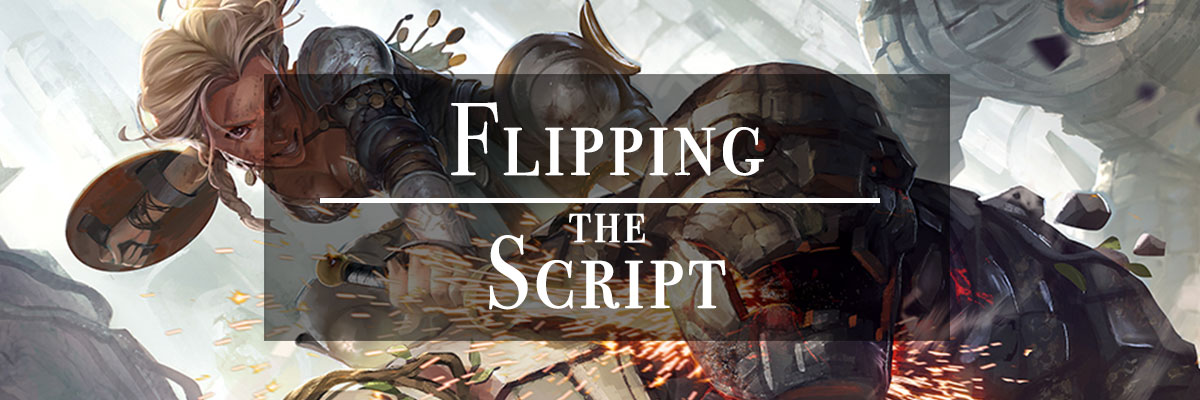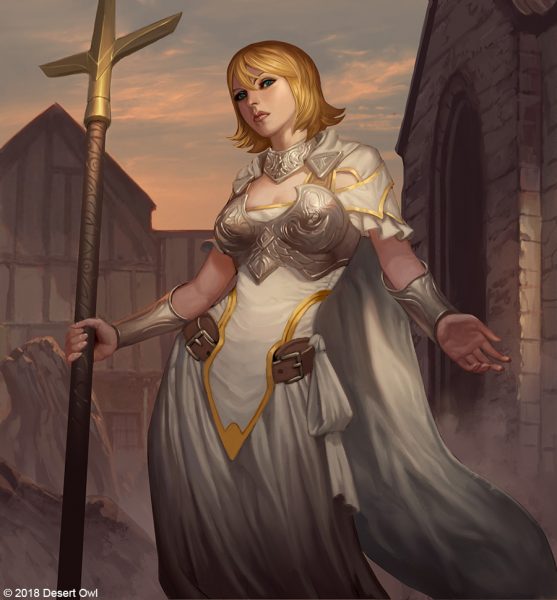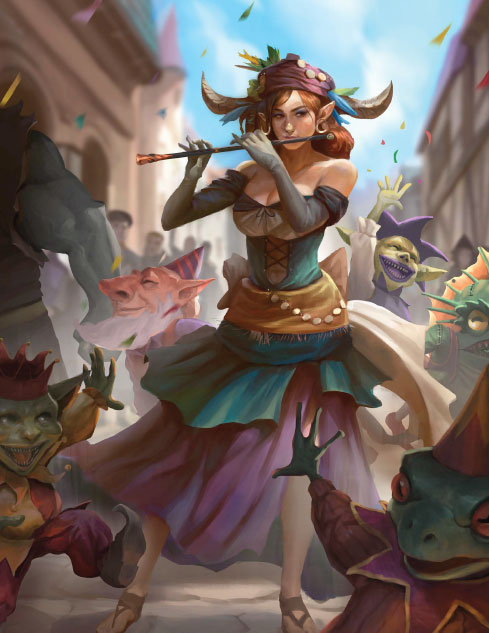Flipping the Script

Monsters and creatures provided in the Monster Manual and additional supplements are full of detail and provide plenty of inspiration to DMs for shaping encounters and creating fun or challenging situations for their party. However, there comes a time when you and your playgroup have nearly exhausted the material you have at hand. Generally speaking, when a DM reaches this point they’re left with two options:
- Homebrew creatures for their campaign; an exciting prospect, but definitely requires a great deal of work.
- Take existing monsters the party has already seen and reverse their intention!
In this post, I’m going to dig into the latter option. Just because you’ve thrown the entire Monster Manual at your players doesn’t mean they’ve seen everything!
Good or Evil?

One of the best places to start when looking at creatures to flip on their heads is alignment. While roleplaying alignment can be interpreted in many ways, for the simple task of adding variance, alignment is a wonderful place to start when thinking about how to express a creature differently. Just ask yourself the question “How creature with an XY alignment look if it had an AB alignment instead?” I find that it’s easiest to start by choosing the exact opposite alignment from what’s initially given on a stat block. One of my favorite creatures to put through this process is a Mind Flayer! A classic D&D villain flipped on its head always makes a lasting impression on your players.
Now, traditionally Mind Flayers are Lawful Evil, meaning they may be privy to abhorrent acts of malice and think nothing of it, but there’s still a structure to their society that they abide by. No matter how sinister, the Mind Flayer still follows a social creed by force or by choice. The specifics of the expressed alignment are up to the DM. On the opposite end of the spectrum, however, is Chaotic Good. This alignment is usually expressed by a personality that fights for the side of justice and fairness in a given scenario but doesn’t pay much attention to the methods used to achieve such a goal. The ends justify the means is certainly a saying that could apply to this alignment. Good aligned creatures won’t step past a certain moral boundary, but Chaotic Good creatures are likely to dance on that line if it means a victory for the side of justice. So how would this affect the personality of a Mind Flayer or a society of Mind Flayers?
Painting the Picture
Using the above example of a Chaotic Good Mind Flayer, let’s create a single NPC as well as a group with these changes. A single Chaotic Good Mind Flayer may be rogue escapee that fled from their society due to a spark of individuality that was directly opposed to the typical Mind Flayer hive mind. Due to a Mind Flayer’s need for brains to survive, perhaps this NPC began living in secret on the surface as an interrogator and eventual executioner for a city. With the Mind Flayer’s ability to manipulate a creature’s mind, they could’ve easily found a place in the inner circle of higher society, should the Mind Flayer gain the trust of those around them.
A society of Mind Flayers like this would take a very different tune. If they lived in the Underdark, they’d easily be a haven for a party fleeing whatever else they may run into in the caverns beneath the surface. The potential for creating tension and a tenuous alliance with a party is massive in this scenario, especially if they expect the Mind Flayers to be evil. Just imagine how trepidatious your party will be while you know that they’re safe! It would be hilarious, and very memorable!
Ok but…Why?
Unless you decide to have your flip-flopped creatures be established in your setting from the beginning, your players will definitely be curious as to why these out of place creatures are the way they are. This is a gift they give you. While it depends on the table, generally speaking, DMs need a good hook to delve into their lore with their playgroup. Having a high profile creature act completely against what makes it high profile is a fantastic hook for fleshing out your world for you and your players. So be sure to give that reason a lot of thought as you craft these odd creature personalities in your world. I touched on an example earlier, but that’s just one of the infinite possibilities you can pull from!

In Conclusion
At the core of it all, flipping intention and personality with a creature is just a tool you can use to spice up your campaign world and give your players a unique experience. How you do that is up to you, and figuring out what flip-flopped creature fits best into your world depends entirely on your setting. So shock your players with a wicked surprise! Floor them with your creativity! Who knows, maybe the cleric thinks an angel was sent by their god to aid the party…when really it’s a fallen one seeking the death of all those who follow said god…
It’s up to you!

Hunter Henrickson
Actor, Gamer, Dungeon Master, Cleric-in-Training
Hunter is an actor who was introduced to D&D when he was 23 but quickly fell in love with the roleplaying and worldbuilding aspects of the game. Taking on multiple roles and personalities as a dungeon master fed right into his love of acting and that, combined with the engaging tactical elements of the game, let him create worlds for he and his friends to explore. He hasn’t looked back since.
Flipping the Script

Monsters and creatures provided in the Monster Manual and additional supplements are full of detail and provide plenty of inspiration to DMs for shaping encounters and creating fun or challenging situations for their party. However, there comes a time when you and your playgroup have nearly exhausted the material you have at hand. Generally speaking, when a DM reaches this point they’re left with two options:
- Homebrew creatures for their campaign; an exciting prospect, but definitely requires a great deal of work.
- Take existing monsters the party has already seen and reverse their intention!
In this post, I’m going to dig into the latter option. Just because you’ve thrown the entire Monster Manual at your players doesn’t mean they’ve seen everything!
Good or Evil?

One of the best places to start when looking at creatures to flip on their heads is alignment. While roleplaying alignment can be interpreted in many ways, for the simple task of adding variance, alignment is a wonderful place to start when thinking about how to express a creature differently. Just ask yourself the question “How creature with an XY alignment look if it had an AB alignment instead?” I find that it’s easiest to start by choosing the exact opposite alignment from what’s initially given on a stat block. One of my favorite creatures to put through this process is a Mind Flayer! A classic D&D villain flipped on its head always makes a lasting impression on your players.
Now, traditionally Mind Flayers are Lawful Evil, meaning they may be privy to abhorrent acts of malice and think nothing of it, but there’s still a structure to their society that they abide by. No matter how sinister, the Mind Flayer still follows a social creed by force or by choice. The specifics of the expressed alignment are up to the DM. On the opposite end of the spectrum, however, is Chaotic Good. This alignment is usually expressed by a personality that fights for the side of justice and fairness in a given scenario but doesn’t pay much attention to the methods used to achieve such a goal. The ends justify the means is certainly a saying that could apply to this alignment. Good aligned creatures won’t step past a certain moral boundary, but Chaotic Good creatures are likely to dance on that line if it means a victory for the side of justice. So how would this affect the personality of a Mind Flayer or a society of Mind Flayers?
Painting the Picture
Using the above example of a Chaotic Good Mind Flayer, let’s create a single NPC as well as a group with these changes. A single Chaotic Good Mind Flayer may be rogue escapee that fled from their society due to a spark of individuality that was directly opposed to the typical Mind Flayer hive mind. Due to a Mind Flayer’s need for brains to survive, perhaps this NPC began living in secret on the surface as an interrogator and eventual executioner for a city. With the Mind Flayer’s ability to manipulate a creature’s mind, they could’ve easily found a place in the inner circle of higher society, should the Mind Flayer gain the trust of those around them.
A society of Mind Flayers like this would take a very different tune. If they lived in the Underdark, they’d easily be a haven for a party fleeing whatever else they may run into in the caverns beneath the surface. The potential for creating tension and a tenuous alliance with a party is massive in this scenario, especially if they expect the Mind Flayers to be evil. Just imagine how trepidatious your party will be while you know that they’re safe! It would be hilarious, and very memorable!
Ok but…Why?
Unless you decide to have your flip-flopped creatures be established in your setting from the beginning, your players will definitely be curious as to why these out of place creatures are the way they are. This is a gift they give you. While it depends on the table, generally speaking, DMs need a good hook to delve into their lore with their playgroup. Having a high profile creature act completely against what makes it high profile is a fantastic hook for fleshing out your world for you and your players. So be sure to give that reason a lot of thought as you craft these odd creature personalities in your world. I touched on an example earlier, but that’s just one of the infinite possibilities you can pull from!

In Conclusion
At the core of it all, flipping intention and personality with a creature is just a tool you can use to spice up your campaign world and give your players a unique experience. How you do that is up to you, and figuring out what flip-flopped creature fits best into your world depends entirely on your setting. So shock your players with a wicked surprise! Floor them with your creativity! Who knows, maybe the cleric thinks an angel was sent by their god to aid the party…when really it’s a fallen one seeking the death of all those who follow said god…
It’s up to you!

Hunter Henrickson
Actor, Gamer, Dungeon Master, Cleric-in-Training
Hunter is an actor who was introduced to D&D when he was 23 but quickly fell in love with the roleplaying and worldbuilding aspects of the game. Taking on multiple roles and personalities as a dungeon master fed right into his love of acting and that, combined with the engaging tactical elements of the game, let him create worlds for he and his friends to explore. He hasn’t looked back since.

0 Comments